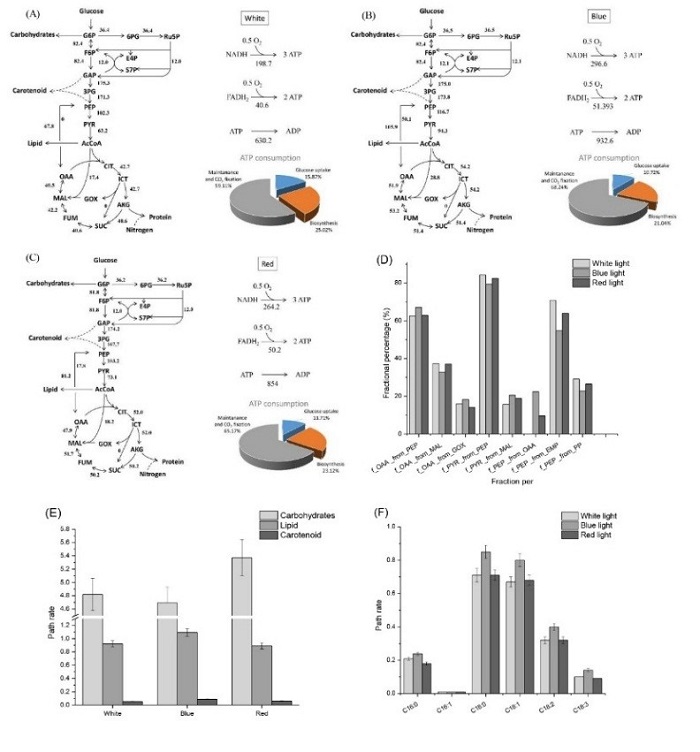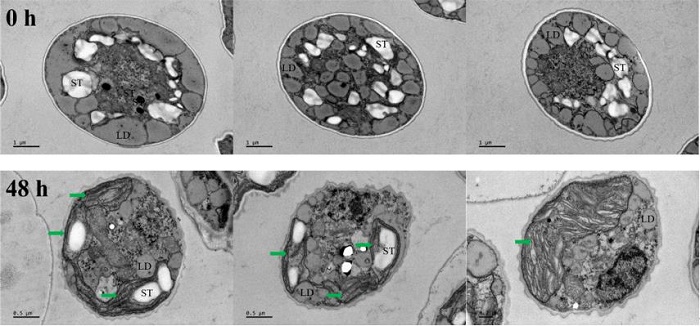Microalgae is a kind of microorganism that can use carbon dioxide or other carbon-containing substances for life activities. Under different culture conditions, microalgae coordinate cell growth and composition by regulating metabolic ways. The biomass and product yield of microalgae depend on culture conditions and can be improved by regulating carbon metabolism. Recently, Professor Feng Chen’s group from IAS made important progress in the field of microalgae’s carbon metabolism.
Dr. Han Sun’s study elucidated storage carbon metabolism in a dynamic manner through kinetic model, metabolomics and stable metabolic flux analysis. Results revealed nutrient uptake rate, carbon availability and synthetic path rate accounted for the integration of process-compatible products. The uptake rate could be enhanced by promoting carbohydrate accumulation, inducing high performance of tricarboxylic acid cycle and anaplerotic routes. Values of specific rate for lipid from kinetic model and synthetic path rate from metabolic flux analysis revealed that conversion of carbon sinks occupied a key position in increasing productivities of lipid and astaxanthin to 302.34 and 1.83 mg g−1 d−1, respectively. Additionally, economic estimation was applied to link cultivation factors with market scenario and demonstrated that regulating such carbon metabolism raised 30% increase of biomass value. This study therefore provided a new orientation to boost carbon efficiency that helped to engineer carbon flux from carbon source to targeted products precisely and rapidly.

Fig. 1: the microalgae’s central carbon metabolism, anaplerotic routes and its product’s precursor rate under different light conditions
In Dr. Zhao Zhang’s study, chloroplasts were found to form after glucose was consumed in Chromochloris zofingiensis under heterotrophic cultivation, accompanied by a significant increase in chlorophyll and primary carotenoids. These changes conferred photosynthetic ability to heterotrophic cells. Meanwhile, both fatty acid and starch were catabolized to provide carbon and energy for cellular metabolism. A comparative transcriptome analysis showed that the expression of genes encoding photosynthetic proteins, as well as enzymes involved in chlorophyll and carotenoid biosynthesis were significantly up-regulated after glucose was consumed. At the same time, genes involved in fatty acid and starch biosynthesis were down-regulated, while those involved in the degradation of these storage molecules were up-regulated. Further investigation by means of enrichment analysis and gene co-expression network analysis revealed that the cells may control the above intracellular changes by directly regulating the expression levels of constitutively photomorphogenic 1, related transcription factors and the peroxisome proliferator-activated receptor signaling pathway. This work, for the first time, highlights the phenomenon of chloroplast morphogenesis in Chromochloris zofingiensis under dark conditions, and suggests possible regulatory mechanisms.

Fig. 2: Transmission electron micrographs of thin-sectioned, heterotrophically-grown C. zofingiensis cells 3 h before and 48 h after glucose consumption (Green arrows: emerging chloroplast; ST: starch granules; LD: lipid droplets)
Two research results were published on the authoritative journals in microalgae field Bioresource Technology (IF=6.669, first district of Chinese Academy of Sciences) and Algal Research (IF=3.723, second district of Chinese Academy of Sciences) respectively. Professor Feng Chen from IAS is the corresponding author.
Ref.:
https://doi.org/10.1016/j.biortech.2019.122640
https://doi.org/10.1016/j.algal.2019.101742


